Fiber Arts Take Over a Former Seaport Warehouse in NYC
See waterfalls of fabric, intricate threadwork, massive tapestries, and more!


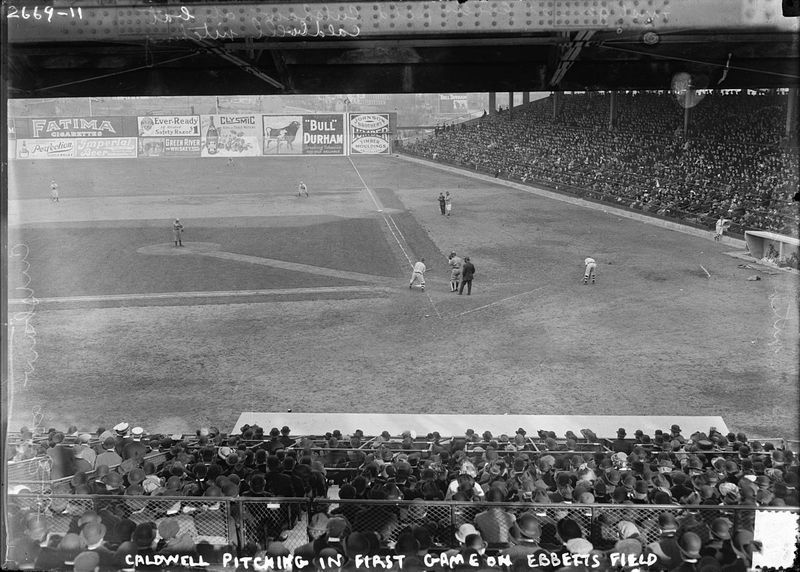
First game at Ebbets Field. Image via Library of Congress Prints and Photographs Division.
Baseball has long been a staple in New York City’s culture. Teams like the Yankees, Mets, Dodgers, and Giants have all called New York home, and the city’s stadiums have been host to some of the sport’s most memorable players and its most historic moments.
Even preceding the move of the Yankees, then called the Highlanders, to New York in 1903, “America’s Past Time” had already had quite the history in this city with all of the original teams from the first baseball organization coming from New York City in the 1850’s. But it wasn’t until teams like the Yankees and Dodgers came into existence that New York’s love for the game became what it is today.
While New York City has an extensive history in regards to the sport of baseball, that hasn’t stopped teams from moving to new cities, or moving forward and moving on to new stadiums, often leaving behind buildings to be demolished.
Here are eight of New York’s lost baseball stadiums:
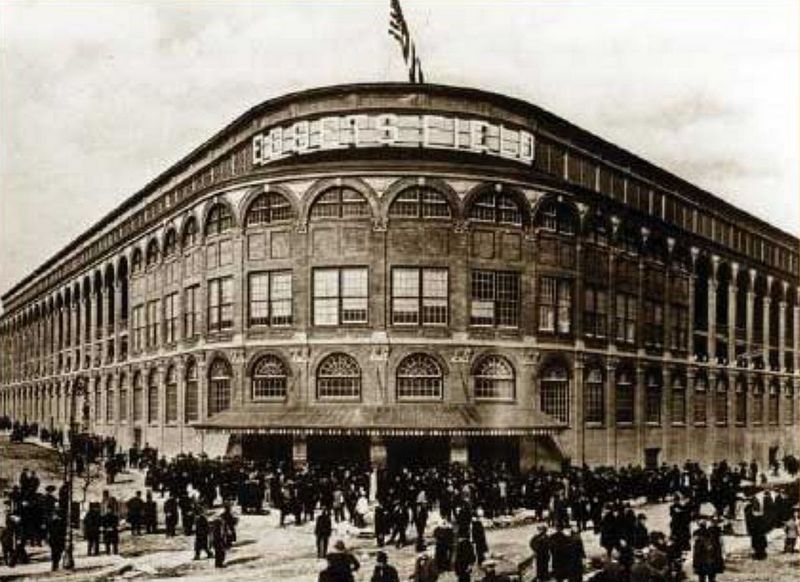
Ebbets Field, opening day, 1913. Image via UCinternational on Wikimedia Commons.
The Brooklyn Dodgers, now the Los Angeles Dodgers, played in several ballparks from their formation in 1883 before their move to the west coast in 1957, but the most commonly known and most popular stadium was Ebbets Field.
Ebbets Field was opened in Flatbush (now considered Crown Heights) in 1913 at 55 Sullivan Place, Brooklyn, NY as the Dodgers’ new home, moving from Washington Park in Park Slope. The official opening was an exhibition game between the Dodgers and the Yankees on April 5, with the game drawing in approximately 30,000 fans, almost twice the seating capacity at the time.
Ebbets Field has been known as one of the most historic ball parks in the country, with some of baseball’s most iconic moments taking place in Flatbush. In not only a defining moment in baseball, but sports in general, Ebbets Field was the home of Jackie Robinson‘s first start in 1947, marking the first time an African-American was in the lineup. Robinson’s break through the color barrier sent shock waves through the world of sports, and created a ripple effect of more and more teams accepting African American players on their teams.
Two years later, in 1949, Brooklyn was once again the location of a defining moment in the breaking of the color barrier, when the first All-Star game to allow players of all races was played in the only All-Star game to be held at Ebbets Field during its tenure.
As the years continued and the Dodgers grew in popularity, Ebbets Field was soon incapable of keeping up with the demand for seating from the fans. With a maximum capacity of 35,000, it was the smallest stadium in the league. This combined with a failed negotiation by Robert Moses to convince Dodgers owner Walter O’Malley to relocate the team to Flushing Meadows led to the team’s relocation to Los Angeles in 1957.
The stadium was torn down soon after, in 1960, and replaced with apartment complexes that still stand to this day.
While very little remembrances of Ebbets Field still exist in New York City, the only mention in the immediate vicinity of where the stadium once stood is a plaque located at the apartment complexes that took its place stating that it was the former site of Ebbets Field.
See the other remnants and reminders of Dodgers history in Brooklyn here. Ebbets Field was located at 55 Sullivan Place, Brooklyn, NY 11225.
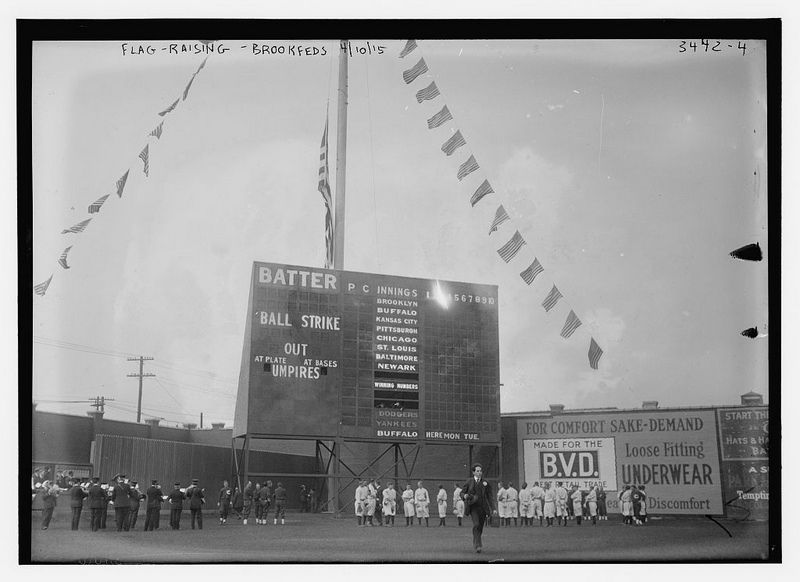
Third version of Washington Park on April 10, 1915. Image via Library of Congress Prints and Photographs Division
Before the move to Ebbets Field, the Dodgers played in a series of ballparks that were collectively known as Washington Park. Washington Park was a group of three separate stadiums in the Park Slope/Gowanus neighborhood between Third Street and Fourth Avenue that were in use by the Dodgers between 1898 and 1912.
The first park was in use from 1883 to 1891, and contained an old building that is now known as the Old Stone House, a site used as a headquarters by General George Washington during the Battle of Long Island during the Revolutionary War. The Old Stone House was also the birthplace of the lost sport of ice baseball.
In 1892, the Dodgers began to split time between the first park of Washington Park and a newer facility called Eastern Park. They continued to split time until 1898 until they moved in to the second version of Washington Park due to poor attendance. The Dodgers’ new home had a unique quality in that the park often smelled due to the surrounding factories and the nearby Gowanus Canal.
During their time spent at the second Washington Park, owner Charles Ebbets slowly invested money into properties in Flatbush, and eventually developed Ebbets Field as the Dodgers’ stadium of the future in 1913.
Once the Dodgers moved to their new stadium, a new professional team, the Brooklyn Tip-Tops, acquired the Washington Park property in 1914 and rebuilt the second park with steel and concrete, replicating the initial Wrigley Field. The Tip-Tops were a short lived team however, and disbanded the following year, leaving the park unused, and eventually demolished in 1926. The property is now owned by Con Edison.
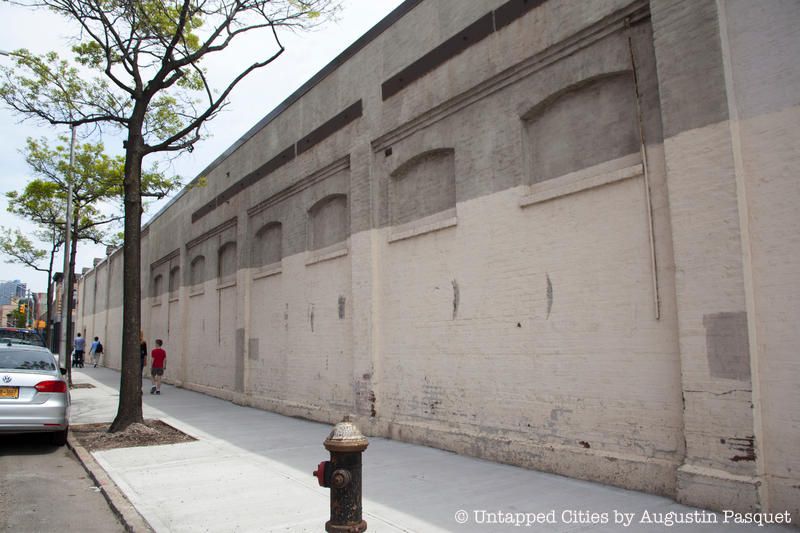
Historical wall from the Tip-Top stadium
A remaining wall is often incorrectly attributed to being the remnants of the Dodgers stadium, but it is now believed to be part of the Tip-Top stadium. Photos from the Tip-Tops era indicate that the windowed wall was the backside of the bleachers, with the openings possibly for horses, and that both parts of the wall likely date to 1914, after the Dodgers left. Ensconced within the parapet portion of the wall was the scoreboard for the game, with advertisements painted on the inside of the wall.
In spite of demolition of some buildings in the property in 2009, Con Edison pledged to keep the wall standing. The wall, of which about half remains, is now the backside to a loading dock. Painted in a pale pink, the wall is an easily missed piece of history in the rapidly developing, post-industrial neighborhood.

Hilltop Park circa 1910. Image via Pictorial News Co. on Wikimedia Commons
Before they were called the New York Yankees, and before they played in the Bronx, the New York Highlanders played at Hilltop Park, originally American League Park, in Washington Heights.
The Highlanders played at Hilltop Park from 1903-1912 and the stadium was even home to the New York Giants in 1911 while the Polo Grounds stadium was being reconstructed. Hilltop Park gets its name from its hilltop location, which granted visitors of the park a wonderful view of the Hudson River and the New Jersey Palisades from behind home plate.
Initial construction of the park only took six weeks to complete and sat 16,000, although several updates were given to Hilltop Park in its short life, including an added 5,000 bleacher seats built in 1911 to help accommodate Giants fans for the season.
The last game was played on October 5, 1912 after both the Giants and Highlanders moved to the newly renovated Polo Grounds following the 1912 season, where the Highlanders were renamed as the more famous Yankees. The building remained unused until its demolition in 1914.
Today, the site where Hilltop Park once resided is the location of Columbia University-New York Presbyterian Medical Center, who acquired the land in 1928. The hospital does honor the former ballpark with a plaque marking the exact location of where home plate was once located.
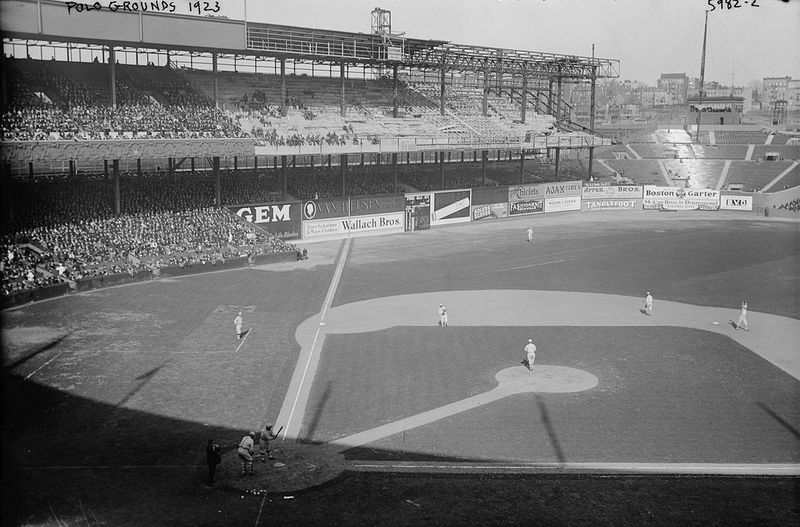
Polo Grounds in 1923. Image via Library of Congress Prints and Photographs Division
The Polo Grounds was opened in 1911 in Upper Manhattan and throughout its tenure was home to the New York Yankees, the New York Giants, as well as the football teams of the New York Giants and New York Jets.
Polo Grounds was actually the name given to multiple ballparks dating back to the late 1800s after the sport of polo, but most historians and common fans refer to the stadium that opened in 1911.
From its official opening to its last days as one of New York City’s great ballparks, the stadium was home to the the New York Giants baseball team and eventually became one of the most beloved, and unique, stadiums in the history of baseball. The Polo Grounds hosted twelve World Series and two All-Star games, and was the location for Willie Mays’ most famous catch in the history of sports.
The Polo Grounds was perhaps most notably known for its odd dimensions and extremely long center field. The distance from home plate to the center field fence was 475 feet, making it one of the longest in baseball history.
The stadium was closed in 1963, after the Giants announced in 1957 their move to San Francisco, and after the new expansion, the New York Mets played in the Polo Grounds until Shea Stadium was completed. The final game was played on September 18, 1963 and the stadium was torn down the following April.
Today, unfortunately like many demolished sports stadiums, very little remains to commemorate the location and history of the field. Several housing projects now stand where the Polo Grounds once drew in thousands of fans, and a plaque is located at the approximate location of home plate. In addition to the plaque commemorating the park, a long staircase from Coogan’s Bluff down to the Polo Grounds was rebuilt in 2015.
Access the site via the Brush Stairway on Edgecombe Avenue from Coogan’s Bluff down to the Harlem River Driveway.
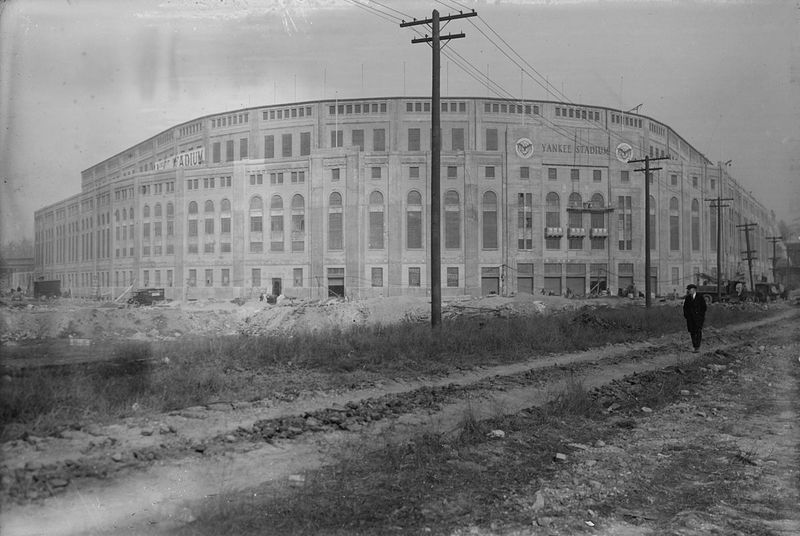
Original Yankee Stadium exterior. Image via Library of Congress Prints and Photographs Division
For a brief tenure from 1913 to 1923, the New York Yankees called the Polo Grounds home as well, before the owner of the Giant grew angry at the popularity of the Yankees and evicted them from the stadium. The team moved north to the Bronx and built the famous Yankee Stadium.
Yankee Stadium was officially opened in 1923, and was paid for completely by the team’s owner, Jacob Ruppert. At the time of its opening, the stadium was considered one of the game’s most unique stadiums due to its odd dimensions and character. Later renovations would shorten the distance, but originally center field was in fact deeper than that of Polo Grounds, reaching 487 feet from home plate to center field, giving it the nickname of “Death Valley”.
The original Yankee Stadium is widely considered one of the most memorable venues, not just in baseball but in New York City and around the world. “The House That Ruth Built” held some of the most historic moments in baseball history until its demolition in 2009.
The early years of the country’s first three tiered sports stadium were critical in the sport’s surge in popularity. Masses of crowds filled the initial 58,000 seats to see names like Babe Ruth and Lou Gehrig in hopes of seeing the then rare home run. These power hitters helped usher in the new “live ball era” of baseball and with it, drew in more and more people to the games.
Due to the increasing popularity and higher demand for seating, Yankee Stadium underwent a series of expansions and renovations throughout its life. Within the first 20 years, the three deck grandstand was extended into left and right field, increasing the seating capacity to roughly 80,000 and the famous “Monument Park” was first erected in 1932. The stadium would undergo minor renovations until the 70s, including the installation of new lights and a scoreboard, but it wasn’t until 1973 that the park close entirely for a massive renovation that included removing and replicating the iconic copper facade along the outfield scoreboard.
Fun fact: The ballpark wasn’t home to just one team called the New York Yankees. From 1946-1949, a football team by the same name played their seasons at Yankee Stadium as a part of the All-America Football Conference and played their last game in Yankee Stadium on December 4, 1949.
In 2006, construction on the new Yankee Stadium began across the street from the original in order to generate more revenue and for the baseball team to update their home. The new stadium kept the same name and opened in 2009 in time for opening day, ushering in a new era of New York City baseball with a World Series win for the Yankees in the new stadium.
Following the demolition of the original stadium in 2009, parts of the stadium including seats, dirt, and grass were auctioned off to fans. Today, Monument Park can be seen in the new Yankee Stadium, as it was moved across the street, and a park called Heritage Field was constructed on the site of the old stadium in remembrance.

Image via Metsfan84 on Wikimedia Commons
During the years that the original Yankee Stadium was closed for renovations in the 1970s, the Yankees shared a home with their neighbors, the New York Mets. Both teams played in the relatively new Shea Stadium.
The stadium was opened in 1964 in Flushing Meadows-Corona Park as a multipurpose stadium for baseball’s New York Mets and football’s New York Jets.
After both the Dodgers and Giants left New York City for the west coast, New York was left without a team in the National League. In 1960, Mayor Robert Wagner reached an agreement with the league to build a new stadium for the owners of an expansion team from the attempted Continental League based in New York.
Shea Stadium held many significant events in sports, including several World Series, as well as many significant events in pop culture. In 1965, The Beatles played their first show in their 1965 North American Tour at the ballpark to a record audience of 55,600. The concert was the first to be held in a major sports stadium and created a trend for larger than life bands and musicians to sell out outdoor stadiums.
The multipurpose stadium was redesigned to specifically a baseball stadium after the Jets moved to Giants Stadium in 1984. It was soon discovered that the stadium had its flaws as strictly a baseball field and talks began in the 1990’s to build a new ballpark near Shea Stadium.
In 2009, the New York Mets moved to the newly constructed Citi Field, and Shea Stadium was dismantled the same year after being given the opportunity to auction off parts and memorabilia to fans.
Like the new Yankee Stadium, Citi Field was built adjacent to the Mets’ former home. Shea Stadium remnants are noted by several plaques and markers in Citi Field’s parking lot which denote the location of home plate, the bases, and the pitchers mound.
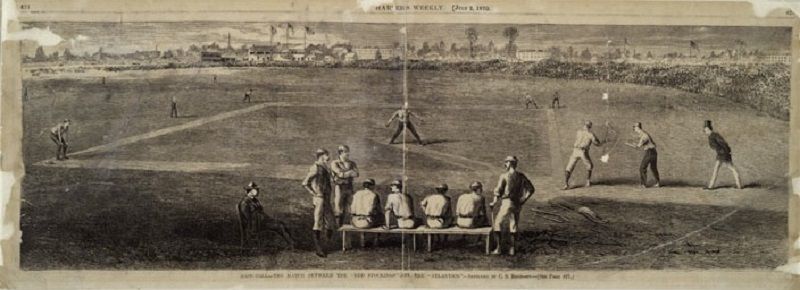
Capitoline Grounds circa 1870. Image via C.S. Reinhart on Wikimedia Commons
While most people, fans of baseball or not, know that the Los Angeles Dodgers were at one point the Brooklyn Dodgers, even the most die hard sports fans in New York City might never have heard of Capitoline Grounds in the Brooklyn neighborhood of Bedford-Stuyvesant.
Capitoline Grounds was home to the Brooklyn Atlantics from 1864-1872, although the only year in which professional baseball was played at the park was in 1872 when the Atlantics joined the professional circuit before leaving for a larger field the following year.
In the short time that Capitoline Grounds was a ballpark, many significant events that would shape the future of baseball occurred at the Brooklyn field. “The finest game ever played” was played between the Atlantics and the Cincinnati Red Stockings, who at the time were considered the greatest team in the world, on June 14, 1870, where the Atlantics would defeat the Red Stockings and end the longest winning streak of all time at 84 games. In 1870, it is also reported by sportswriter Henry Chadwick that the first public display of the curveball was demonstrated by Fred Goldsmith, Before the display, Goldsmith’s curveball was only believed to be an optical illusion.
Before its demolition in 1880, Capitoline Grounds was used as an ice rink during the winter when they froze over the fields.
Today, no remaining traces of Capitoline Grounds can be found at its original location, but the park has been referenced in today’s culture briefly. In 2014, a coffee shop with the same name as the ballpark opened along Flatbush Avenue in Brooklyn, not too far from the site of the field (though the shop is now closed). Capitoline Grounds has also been referenced in a 1990 novel, If I Never Get Back: A Novel by Darryl Brock.
Visit where the site was at the block bound by Halsey Street, and Marcy, Putnam, and Nostrand Avenues. Brooklyn
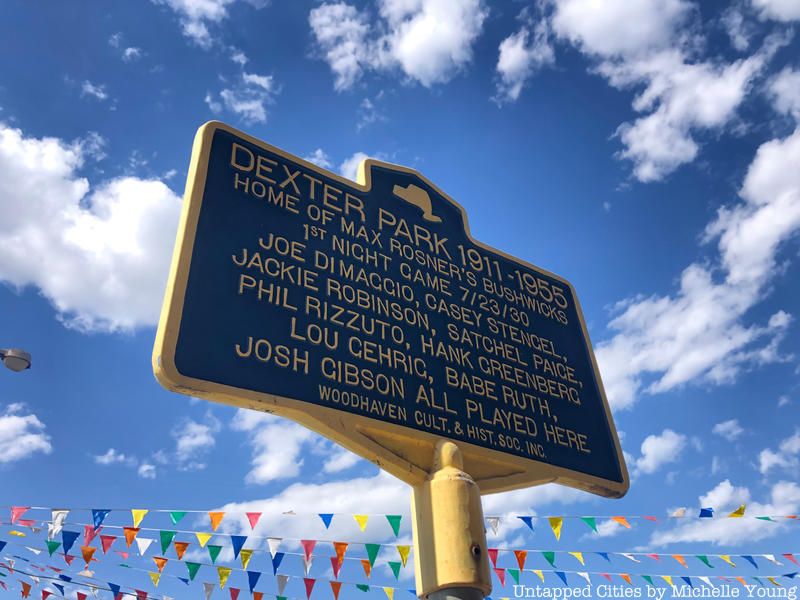
Long before Jackie Robinson broke baseball’s color barrier with the Brooklyn Dodgers, many African-American players set up Negro League teams so they could play. While these teams typically didn’t play major league teams like the Yankees or Dodgers, they played their own seasons against each other and sometimes against independent, semi professional teams. One such independent team was the Brooklyn Bushwicks, who called the Woodhaven, Queens park home from 1913 to 1951 when the team disbanded.
The Brooklyn Bushwicks spent their years at Dexter Park playing some of the greatest baseball players of the era. The likes of Babe Ruth,Lou Gehrig, and Dizzy Dean played against the Bushwicks from major league teams, while some of the greatest African-American players to have ever played the game have opposed the Bushwicks at Dexter Park. Negro League stars like Josh Gibson and “Cool Papa” Bell were major draws for fans of the sport.
Dexter Park was purchased in 1922 by team owner Max Rosner from the Ulmer Brewery. Recognizing the potential in his team, Rosner had a grandstand built the following year that could seat approximately 2,000 people and then an additional 2,000 seats were added in 1924.
The park was also home to the Negro League team the Brooklyn Royal Giants during their years as a part of the Eastern Colored League from 1923 to 1927.
After the Bushwicks folded in 1951, Dexter Park was used as a stock car race track until it was sold in 1955.
Dexter Park was located in the Queens neighborhood of Woodhaven, just north of Eldert Lane and Jamaica Avenue, on the Queens-Brooklyn border. The park was torn down in June of 1957. Today, the ballpark is commemorated by a New York State plaque.
With New York City still showing extreme love and dedication to the sport of baseball, there is no doubt that the city’s current stadiums will develop their own unique history and in time, be remembered like New York’s stadium of the past.
Next, check out 10 Former and Lost Sporting Venues in and Around NYC and The Day Baseball Died in Brooklyn-Ebbets Field. Get in touch with the author on Instagram @mrich20.
Subscribe to our newsletter